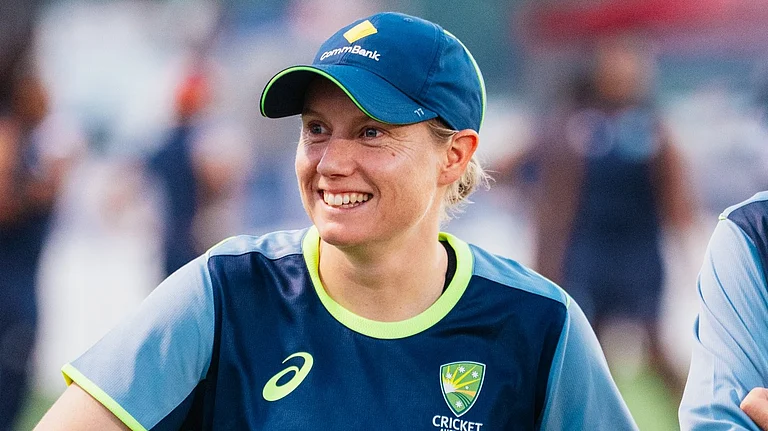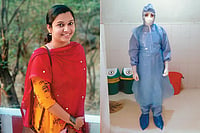From the tarmac, Graciemol Thomas spied the modest two-storey airside terminal at the Calgary international airport and knew she was going to be alright. All of 22 years as she stepped off her second trans-continental flight in as many days in 1971, the devout ingénue from Kuttoor, a “small village just beyond” the municipal bounds of Tiruvalla in Kerala’s Bible belt, recalls the tears of relief as handmade ‘Welcome to Canada’ placards went up in the public viewing area. Cold, inhospitable London had left the trained, but unseasoned, paediatric nurse thinking she was in over her head. A day later, still fighting jetlag, Thomas made the four-hour drive to Blairmore, the nondescript Albertan community the “village girl” would call home for nearly four decades.
“It was, as they say, white bread. Most had never seen a person of colour before, let alone one in a sari. But instantly, I knew it was a place I could settle down in. A close-knit god-fearing group of people full of warmth, it reminded me of home,” says Thomas, who arrived in Canada—where prime minister Lester B. Pearson had in 1967 (the US too opened its doors to overseas-trained nurses the same year) brought in a ‘points’ system for skilled migrants—as part of the University of Calgary’s pilot rural health outreach programme. Like her designated frontier town, Thomas (née Punnen) was a pioneer—part of a new wave of émigré nurses from Kerala to look past the Gulf and the UK to ‘settle’ the Commonwealth’s outer reaches. In so doing, they changed the faces of both their new homes (literally) and the old country (figuratively). Kerala finance minister Thomas Isaac calls them the “unsung heroes behind the state’s economic growth...nobody has recognised their contribution”.
Considered the cultural capital of the central Travancore region, Tiruvalla in Pathanamthitta district—one of Kerala’s largest NRI pockets—has capital assets of over Rs 10,000 crore deposited in the coffers of around 50 banking institutions (across its three sq km municipal radius). Annual NRI deposit mobilisation targets are generally reached in the first fiscal quarter. A top bank executive says, “Although the COVID-19 pandemic has necessitated revisions of some projections, even times of uncertainty, as during demonetisation, do not dent remittance flows for too long.” In a township where, she says, the average NRI patron remits Rs 15-20 lakh, transactions in single-digit crores are part of the norm, as are starry meets and galas. Where nurses fall in this range is anyone’s guess since sector-specific data is hard to come by.
Estimating that Kerala’s nurses accounted for over 30 per cent of Malayalis working in the UK or the US, a November 2017 World Health Organization (WHO) report on the state’s migrant nurses states simply, “Nursing as a profession offers scope for better quality of living for migrants. Increased earnings and consequent remittances (except in the case of permanent migration) also contribute to the economy of the source state.” The bigger takeaway: this nugget about the Malayali nurse contingent in Australia (15 per cent of the sector force) outnumbering their compatriots spread throughout West Asia (12 per cent) by three whole percentage points—suggesting perhaps that the Gulf might no longer be as enticing a springboard to greener pastures as it once was? But, we hit the wall of lack of data again. Praveena Kodoth at the Centre for Development Studies (CDS) in Thiruvananthapuram suggests that “it may be difficult to disaggregate remittances according to occupation”. Broadly though, Kodoth adds, it can be understood that “remittances are likely to be from nurses in the GCC nations who are largely migrants that plan to retire at home if they don’t plan to move to the West. Migrants to OECD nations are largely settlement migrants who are likely to remit much less than they invest in their destination country”.
Thomas concurs. “It was only after marriage and my husband (Thomas Eapen from Tiruvalla) finding work that we could build a family home. Before then, I saved and sent back most of what I earned save for the odd movie ticket. I had few friends and didn’t care to socialise beyond church. Once we were comfortable, we did send back whatever we could spare,” says the 70-year-old who lives in Calgary during the summer, spring and fall months before—like many NRK pensioners—retreating to their “winter home” in Tiruvalla.
The influx of wealth has given the ‘small town’ Thomas remembers a facelift, with palatial ‘Gulf houses’ and luxury highrises towering over traditional nalukettu tharavadus (ancestral homes). Also ubiquitous are airline offices, jewellery and garment showrooms and overseas recruitment agencies catering mainly to a middle-class that is gradually being priced out. Commodity costs have risen—residents pay close to the dollar equivalent for fish and other food products in the market—almost as quickly as the soaring property values. All of which has reportedly fomented social insecurity, even unrest. In a town where, according to the 2011 Census, Hindus and Christians comprise 46.92 per cent and 48.03 per cent respectively of the 52,883 population, communal amity is no buzzword.
To put this into context, the total remittances to Kerala (through to March 2018) was listed at Rs 85,092 crore—accounting for 35 per cent of the state’s GDP—in the Kerala Migration Survey (KMS) 2018, the latest entry in a long-running series of labour flow studies by CDS. In that time period, the State Level Bankers Committee—a forum of major banks mediating with the government on banking sector issues—and the Kerala Economic Review 2019 noted that NRI remittances account for 39 per cent of all bank deposits. A CDS working paper, released January 2019, titled ‘Emigration and Remittances: New Evidence From The Kerala Migration Survey, 2018’ delved deeper, finding that household remittances—a measure of household income—to Kerala (prior to March 2018) was Rs 30,717 crore. This went towards meeting day-to-day expenses, paying back debts, paying for education and weddings (including dowry), constructing/renovating a house and investing in real estate, purchasing a vehicle or some gold, starting a business, religious donations and gifts. In addition, it contributed to household savings, whether as cash in hand or in the bank.
By some estimates, the remittance economy has made the average Malayali about 50 per cent wealthier than his fellow citizen. There was a time when Tiruvalla enjoyed the highest per capita income in the country. Migration is a part of the puzzle. At the taluk level, KMS 2018 notes, Tiruvalla is home to the highest percentage for non-resident Keralites (NRK) by total population (28.6 per cent)—doubling the district’s figure (14 per cent). The taluk has about 61,758 NRKs with some 96.9 NRKs per 100 households—the highest in a state where roughly a tenth of the population lives abroad. In a real sense, Tiruvalla is a microcosm of the Kerala migrant nurse phenomenon.
When she can, Thomas mentors young nurses from Kerala. At over $40 per hour, Alberta offers some of the best wages for registered nurses in Canada—but the expense involved in earning the coveted RN licence verges on the prohibitive. Accredited bridge programs for foreign nurses go on for at least 18 months and can run upwards of $30,000. Besides the cost of actually getting to and into Canada, there are living expenses, as also binding non-employment terms. Thomas maintains that migrant nurses have never had it so good. Anuradha Nair, who moved to Toronto in 2018 and is saddled with a Rs 15-lakh debt, thinks otherwise. Unable to work till she clears the NCLEX-RN, a rigorous entry-to-practice exam, Nair worries about the future. “My father took out loans to send me here and to fund my education. If I don’t start earning soon, it will be too much,” says Nair, from Niranam village—just off the Tiruvalla-Kottayam stretch and a hub of migration. Early access to quality education and some of the state’s oldest schools—the Church Missionary Society College Kottayam, set up in 1817, for instance—has driven high literacy rankings, including high female literacy rates, in Pathanamthitta and Kottayam districts.

Ida S. Scudder, founder of Christian Medical College, Vellore, with the first batch of Indian nurses.
“Nurses have been drawn from relatively poor, but upwardly mobile families. In the early years, it was an economic strategy for large Syrian Christian families with many surviving children that found it difficult to provide dowries for daughters. Staring at downward mobility, education and employment as nurses offered a way out as it brought in financial resources to educate younger siblings and to pay dowries. Back then, there were no professional nursing courses in Travancore, so Syrian Christian girls travelled elsewhere in the country seeking education,” says Kodoth, adding that a tour by the nursing programme head at Christian Medical College, Vellore, helped kickstart the outward movement trend of women from ‘respectable’ Syrian Christian families. Also, strong alumni networks at the nursing colleges (the Kerala Nurses and Midwives Council recognises over 100 nursing colleges today) allowed graduates to secure channels of migration—a phenomenon “premised on social networks and connections”—better than those who were dependent on potentially exploitative recruitment agents.
Nair credits her alma mater, Pushpagiri College of Nursing, founded in Tiruvalla in 2002, as one of Kerala’s earliest private self-financing nursing colleges with the training and opportunity to go abroad. Connections, though, were harder to come by. Not so for Lubna S., a section nurse at a major hospital chain in Muscat. The 34-year-old from Malappuram—listed in KMS 2018 as the highest migrant-sending district, with 4,06,054 NRKs—arrived in Oman in 2010 after four years at a private hospital in Kochi. Despite a stagnating income due to the oil crisis-hit economy, she pulls in “around 850 Omani Rials” (roughly Rs 1.7 lakh) a month after earning a starting salary of 700 OMR (Rs 1.4 lakh now). “Since my sister put me up, fed and drove me, I could claim these allowances as cash reimbursements. I could send back more than half my take home (about Rs 80,000 at today’s rates) every month. My colleagues too sent back large sums thanks to the tax-free income and other hospital subsidies,” says Lubna, who has built a home in her husband’s village that the couple hopes to retire to.
Even ahead of the COVID-19 pandemic, expatriate nurses across the GCC were fearful that their jobs would be lost to nationalisation. ‘Omanisation’, a decades-old project to encourage hiring of Oman’s native worker base, has got a fillip in recent years. It is Saudi Arabia’s nitaqat scheme, however, that has caused nurses much heartache. Since the Union government included nurses in the Emigration Check Required (ECR) category—wherein migration to 18 countries needs clearance from Protector of Emigrants (POE)—in April 2015, Kerala’s ECR numbers rose to 4,719 applications (mainly to Saudi Arabia) by November 2018. The closure of lucrative Kuwait to Indian nurses, a pay-off for a recruitment scam unearthed at the POE in Kochi—one of two in Kerala—as well as rumours of tit-for-tat hiring practices (where a GCC country agrees to take a certain number of nurses from a private recruitment agency in exchange for a ‘commiserate’ number of domestic workers) have dented migrant confidence—already in short supply with a bureaucracy straight out of a Max Weber fever dream—in the Emigration Clearance (EC) regime. Though, with an estimated 7,000 nursing graduates entering the state’s workforce yearly to earn a pittance in the private sector, there is no shortage of takers even if the numbers are not as giddying as they once were. The CDS working paper notes that some “33.2 per cent of nurses are at the pre-migration period”, highlighting both the continued demand for Malayali nurses. It also notes that the emigration of women in Kerala—pegged at 15.8 per cent of some 21 lakh emigrants—is chiefly concentrated in the nursing profession, which accounts for five per cent of all emigration.
Since 2015, the two authorised government-run agencies: NORKA-Roots and Overseas Development and Employment Promotion Consultants (ODEPC) have together only recruited 2,800 nurses (over 80 per cent of whom were women) even after recruitment charges were standardised at Rs 35,000 in all. Add another zero to that figure to arrive at an approximation of the fees charged by some 50-70 active private agencies in the state and yet, they do brisk business because of their advertised “exclusive contracts” with GCC ministries as well as “tie-ups” with immigration lawyers and recruitment companies elsewhere.
Things came to a head in 2017 when the so-called ‘Jasmine Revolution’ bloomed—as lakhs of nurses protested the poor compensation, inordinately long duty hours, predatory recruitment practices and artificial staffing shortages, among other concerns. The nurse diaspora, chock full of disgruntled employees, ‘informally’ supported the work stoppage by remitting to finance transport and rooming costs besides lending moral support on TV channels and social media networks. In 2018, allegedly on “the wings of Malayali nurses”, the revolution spread to New Zealand where more than 30,000 nurses across the country protested against poor pay and work conditions by walking off the job for a day in the first-such labour action in three decades.

A nurse treats a COVID-19 patient in Rome. No relation with the nurse from Lombardy (below).
“Actually, that’s not quite right. It may have been forgotten but there was a protest in 2012 by around 150 Indian, mostly Malayali, nurses on the steps of the New Zealand parliament after they were cheated and lied to by the New Zealand Nursing Council,” says Subin Chacko, who was part of that agitation and a follow-up hunger strike in the winter held at, symbolically, the foot of a Mahatma Gandhi statue in Wellington railway station. “This was after the earthquakes of 2011 where a critical shortage of nurses was noticed. The council told us that a three-year general nursing diploma and an English language test was all that would be required to work here. That was not true. Ultimately, even after the protest, only those who had completed the four-year BSc were allowed to work.”
Chacko—who has since found work as an RN at a district health bureau in Auckland—now earns over $75,000 (roughly Rs 35 lakh) a year and saves about $10,000 in that period, most of which he sends home for his Kollam-based parents’ upkeep and to pay off interest on debts, besides EMI payments on a 3BHK flat in town. That didn’t stop him from returning to the picket lines in 2018 though. As he says, “It’s about respect.” A common concern raised by nurses Outlook spoke to, both across the Malayali diaspora and at home. That a BBC video of former UK MP Anna Soubry acknowledging the efforts of Kerala’s nurses was widely shared (and referred to by two nurses over the course of interviews) by nursing unions across the state on social media is telling. For Thomas, the recognition she never sought came in 2013 when the Syro-Malabar Church’s laity commission hailed the efforts of emigrant nurses towards helping the state’s Catholic community “ride out” agrarian crises and weather economic hardships.
“Whether you earn Rs 30,000 in a government hospital here or making lakhs overseas, respect is the only real currency,” says Anas S.M., a nurse in the A&E ward at the Government Medical College in Thiruvananthapuram who has just wrapped up a two-week quarantine after a stint in the Corona ward. “The only time the public respects us is when they need us. But what about our needs? Do they care that I haven’t seen my infant child and wife for three months because I have to take care of the patients?” asks Anas, the district president of Kerala Government Nurses Union—a body born from the Jasmine Revolution. His heartfelt angst echoes around the world, taken up by other voices, in these fraught days.

























